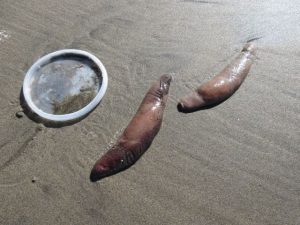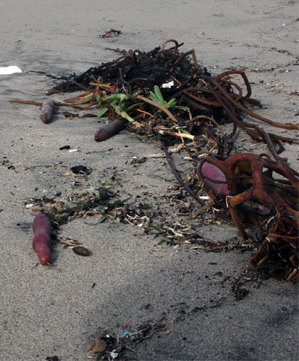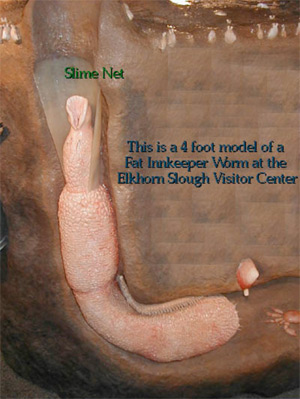
October 2016–While walking along the beach at Pajaro Dunes on Saturday, October 29, 2016, beachgoers saw literally millions of fat innkeeper worms washed ashore.
“We walked from Beach Road over the dunes, and 1.75 miles down to the mouth of the Pajaro River. There were so many, you could hardly help stepping on them,” reports Sam Earnshaw. “We didn’t walk to the north, but it looked like they continued up that way. There were lots of seagulls, but only a few would pick them up, wash them in the ocean, and reluctantly gulp them down. Sometimes they would just drop them.”
Sam headed back to the beach on Wednesday, November 2, 2016 and was surprised to see the beach completely clear of them. “The tide had come up past the zone where we walked before. We only found two of them, tucked in a big clump of seaweed.”
February 2010–If you walked the beach last week near Pajaro Dunes or Manresa beaches, you may have noticed what looked like hot dogs washed up on the sandy shore. These odd-looking “hot dogs” are actually marine animals called fat innkeeper worms (Urechis caupo). They normally inhabit U-shaped burrows in sand or mud, hidden from view except for the small burrow openings. So what are fat innkeeper worms and why have they suddenly littered our beaches?

Large numbers of the fat innkeeper worms washed up on shore were reported last week during Beach Coastal Ocean Mammal and Bird Education and Research Surveys (COMBERS). This collaborative effort between Moss Landing Marine Labs (MLML), the Monterey Bay National Marine Sanctuary (MBNMS) and other research institutions trains volunteers to survey marine birds and mammals at select beaches in the Monterey Bay. Because the beaches are surveyed on a monthly basis, changes or patterns can be easily identified and in this case, sporadic events recorded. It is thought that the fat innkeeper worms washed ashore due to winter storm swell that has scoured beaches and led to large amounts of sediment transport along the coast. Because fat innkeeper worms live in the sand, the movement of sediment from waves and currents could have uprooted them from their homes and deposited them on the beach. This year, partly due to the effects of El Nino, California is experiencing high-energy storms, affecting ocean currents, rainfall and surf swell.

An adult fat innkeeper worm is 15-25 cm long and commonly burrows in areas with sandy mud, like the Elkhorn Slough. One end ofthe burrow has a mud collar, which looks like a mini-volcano, through which the worm pumps water in order to feed. Across the opening of the collar the worm secretes a slime net, enabling the worm to trap food particles as it pumps water through the tunnel. When the slime net is loaded with food, the worm ingests the entire net, eating the collected plankton and rejecting larger particles. These items do not go to waste, however, they are eaten by commensal species that reside with the worm in its burrow. This is how the worm got the innkeeper name. Species that are known to live with the fat innkeeper worm include the small pea crab (Scleroplax granulata), scale worm (Hesperonoe adventor), goby (Clevelandia ios) and commensal clam (Cryptomya sp.).
Though the fat innkeeper worm is buried in the mud, it is not without predators. In the Elkhorn Slough, bat rays (Myliobatis californica) have been known to suck them out of their burrows. Additionally, fat innkeeper worms make up around 10% of the diet (by weight) of the Southern Sea Otters (Enhydra lutris nereis) near Elkhorn Slough. While the loss of the worms on the beach should not have a substantial impact on either of these populations, it is important to continue to monitor the beaches of the Monterey Bay, especially during this winter storm season.
|